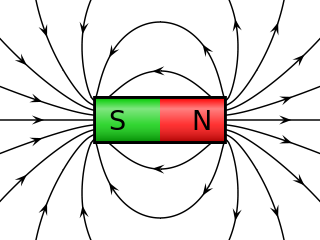Definition of a Magnetic Field
A magnetic field is a vector field that describes the magnetic influence on moving electric charges, electric currents, and magnetic materials. The magnetic field at any given point is specified by both a direction and a magnitude (strength). It is typically represented by the symbol B and is measured in teslas (T) in the International System of Units (SI). Magnetic fields are created by moving electric charges and intrinsic magnetic moments of elementary particles associated with a fundamental quantum property called spin.
Detailed Concept of a Magnetic Field

1. Origin of Magnetic Fields:
- Moving Electric Charges: When electric charges move, they create a magnetic field. This is the basis of electromagnetism. For instance, a current-carrying wire generates a magnetic field that forms concentric circles around the wire.
- Intrinsic Magnetic Moments: Elementary particles, like electrons, have an intrinsic magnetic moment due to their spin. This quantum mechanical property means that even without moving charges, certain materials can have permanent magnetic moments.
2. Description and Representation:
- Field Lines: Magnetic fields are often visualised using field lines, which indicate the direction and strength of the field. The density of the lines indicates the strength of the field; closer lines mean a stronger field.
- Vectors: Mathematically, the magnetic field is a vector field. At each point in space, it is described by a vector with both a direction and a magnitude. This vector can be determined by the force that the field exerts on a moving charge.
3. Laws Governing Magnetic Fields:
- Biot-Savart Law: Describes the magnetic field generated by a steady current. It states that the magnetic field dB at a point in space due to a small segment of current I is proportional to the current and inversely proportional to the square of the distance from the segment.
- Ampère’s Law: Relates the integrated magnetic field around a closed loop to the electric current passing through the loop. It is often used to calculate the magnetic field of current-carrying conductors.
- Faraday’s Law of Induction: States that a changing magnetic field can induce an electric current in a circuit. This is the principle behind many electrical generators and transformers.
- Lorentz Force Law: Describes the force experienced by a moving charge in a magnetic field. The force is perpendicular to both the velocity of the charge and the magnetic field, given by the cross product F = q(v × B), where F is the force, q is the charge, v is the velocity, and B is the magnetic field.
4. Types of Magnetic Fields:
- Uniform Magnetic Field: The magnetic field has the same magnitude and direction at every point. This is an idealisation, often used in physics problems to simplify calculations.
- Non-Uniform Magnetic Field: The magnitude and/or direction of the magnetic field varies with position. This is more common in real-world scenarios.
Examples of Magnetic Fields
Earth’s Magnetic Field:
- The Earth itself acts like a giant magnet with a magnetic field extending from the Earth’s interior out into space. This geomagnetic field is what compasses detect, allowing for navigation. The field resembles that of a bar magnet tilted about 11 degrees from the Earth’s rotational axis.
Bar Magnet:
- A simple bar magnet has a magnetic field with a distinct north and south pole. The field lines emerge from the north pole and curve around to enter the south pole, creating a loop. The strength of the field decreases with distance from the magnet.
Electromagnets:
- Created by running an electric current through a coil of wire. The magnetic field strength can be increased by increasing the current or the number of turns in the coil. Electromagnets are widely used in devices such as electric motors, transformers, and relays.
Solenoids:
- A solenoid is a type of electromagnet where the wire is coiled into a helix. When current flows through the solenoid, a uniform magnetic field is created inside the coil, making solenoids useful in applications requiring controlled magnetic fields.
MRI Machines:
- Magnetic Resonance Imaging (MRI) machines use strong magnetic fields to align the nuclear magnetisation of hydrogen atoms in the body. By applying a radio frequency current, the MRI can produce detailed images of internal body structures.
Galactic Magnetic Fields:
- Magnetic fields are not limited to Earth. They exist throughout the universe, including in galaxies. These fields influence the formation and evolution of astronomical structures and can be observed through their effects on cosmic rays and radiation.
Conclusion
Magnetic fields are fundamental aspects of the physical world, underlying a wide range of natural phenomena and technological applications. From guiding navigation with compasses to enabling advanced medical imaging techniques, understanding magnetic fields is crucial for both scientific exploration and practical innovation.




